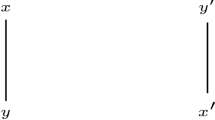Abstract
We determine the order dimension of the strong Bruhat order on finite Coxeter groups of types A, B and H. The order dimension is determined using a generalization of a theorem of Dilworth: dim (P)=width(Irr(P)), whenever P satisfies a simple order-theoretic condition called here the dissective property (or “clivage”). The result for dissective posets follows from an upper bound and lower bound on the dimension of any finite poset. The dissective property is related, via MacNeille completion, to the distributive property of lattices. We show a similar connection between quotients of the strong Bruhat order with respect to parabolic subgroups and lattice quotients.
Similar content being viewed by others
References
Billey, S., Jockusch, W. and Stanley, R. (1993) Some combinatorial properties of Schubert polynomials, J. Algebraic Combin. 2(4), 345–374.
Birkhoff, G. (1973) Lattice Theory, 3rd edn, Amer. Math. Soc. Colloq. Publ. 25, Amer. Math. Soc.
Björner, A. and Brenti, F., Combinatorics of Coxeter Groups, Graduate Texts in Math., Springer-Verlag, to appear.
Björner, A. and Brenti, F. (1996) An improved tableau criterion for Bruhat order, Electron. J. Combin. 3(1), Research Paper 22.
Björner, A. and Wachs, M. (1988) Generalized quotients in Coxeter groups, Trans. Amer. Math. Soc. 308(1), 1–37.
Björner, A. and Wachs, M. (1997) Shellable nonpure complexes and posets. II, Trans. Amer. Math. Soc. 349(10), 3945–3975.
Chajda, I. and Snášel, V. (1998) Congruences in ordered sets, Math. Bohem. 123(1), 95–100.
Deodhar, R. and Srinivasan, M. (2001) A statistic on involutions, J. Algebraic Combin. 13(2), 187–198.
Dilworth, R. (1950) A decomposition theorem for partially ordered sets, Ann. of Math. (2) 51, 161–165.
Elkies, N., Kuperberg, G., Larsen, M. and Propp, J. (1992) Alternating sign matrices and domino tilings (Part I), J. Algebraic Combin. 1(2), 111–132.
Fan, K. (1972) On Dilworth's coding theorem, Math Z. 127, 92–94.
Felsner, S. and Trotter, W. (2000) Dimension, graph and hypergraph coloring, Order 17(2), 167–177.
Flath, S. (1993) The order dimension of multinomial lattices, Order 10(3), 201–219.
Garsia, A. and Stanton, D. (1984) Group actions on Stanley-Reisner rings and invariants of permutation groups, Adv. Math. 51(2), 107–201.
Geck, M., Hiss, G., Lübeck, F., Malle, G. and Pfeiffer, G. (1996) CHEVIE-A system for computing and processing generic character tables for finite groups of Lie type, in Weyl Groups and Hecke Algebras, AAECC 7, pp. 175–210.
Geck, M. and Kim, S. (1997) Bases for the Bruhat-Chevalley order on all finite Coxeter groups, J. Algebra 197(1), 278–310.
Grätzer, G. (1998) General Lattice Theory, 2nd edn, Birkhauser, Boston.
Hoffman, K. and Padberg, M. (2001) Set covering, packing and partitioning problems, in C. A. Floudas and M. Pardalos (eds), Encyclopedia of Optimization, Kluwer Academic Publishers, Dordrecht.
Humphreys, J. (1990) Reflection Groups and Coxeter Groups, Cambridge Stud. in Adv. Math. 29, Cambridge Univ. Press.
Kung, J., Personal communication.
Lascoux, A. and Schützenberger, M.-P. (1996) Treillis et bases des groupes de Coxeter, Electron. J. Combin. 3, #R27.
MacNeille, H. (1937) Partially ordered sets, Trans. Amer. Math. Soc. 42(3), 416–460.
Markowsky, G. (1992) Primes, irreducibles and extremal lattices, Order 9(3), 265–290.
Okada, S. (1993) Alternating sign matrices and some deformations of Weyl's denominator formulas, J. Algebraic Combin. 2(2), 155–176.
Rabinovitch, I. and Rival, I. (1979) The rank of a distributive lattice, Discrete Math. 25(3), 275–279.
Reading, N. (2002) Lattice and order properties of the poset of regions in a hyperplane arrangement, Preprint.
Reading, N. (2002) On the structure of Bruhat order, Ph.D. dissertation, University of Minnesota.
Robbins, D. (1991) The story of 1, 2, 7, 42, 429, 7436,..., Math. Intelligencer 13(2), 12–19.
Rozen, V. (1991) Coding of ordered sets, Ordered Sets and Lattices 10, 88–96 (Russian).
Schönert, M. et al. (1995) GAP-Groups, Algorithms, and Programming, 5th edn, Lehrstuhl D für Mathematik, Rheinisch Westfälische Technische Hochschule, Aachen, Germany.
Simion, R. (1999) A type-B associahedron, Preprint.
Stanley, R. (1997) Enumerative Combinatorics, Vol. I, Cambridge Stud. in Adv. Math. 49, Cambridge Univ. Press.
Trotter, W. (1992) Combinatorics and Partially Ordered Sets: Dimension Theory, Johns Hopkins Series in the Math. Sci., The Johns Hopkins Univ. Press.
Author information
Authors and Affiliations
Rights and permissions
About this article
Cite this article
Reading, N. Order Dimension, Strong Bruhat Order and Lattice Properties for Posets. Order 19, 73–100 (2002). https://doi.org/10.1023/A:1015287106470
Issue Date:
DOI: https://doi.org/10.1023/A:1015287106470




